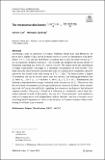| dc.contributor.author | Sah, Ashwin | |
| dc.contributor.author | Sawhney, Mehtaab | |
| dc.date.accessioned | 2024-04-01T18:13:37Z | |
| dc.date.available | 2024-04-01T18:13:37Z | |
| dc.date.issued | 2024-03-30 | |
| dc.identifier.issn | 0178-8051 | |
| dc.identifier.issn | 1432-2064 | |
| dc.identifier.uri | https://hdl.handle.net/1721.1/153985 | |
| dc.description.abstract | Answering a pair of questions of Conrey, Gabbard, Grant, Liu, and Morrison, we prove that a triplet of dice drawn from the multiset model are intransitive with probability
$$1/4+o(1)$$
1
/
4
+
o
(
1
)
and the probability a random pair of dice tie tends toward
$$\alpha n^{-1}$$
α
n
-
1
for an explicitly defined constant
$$\alpha $$
α
. This extends and sharpens the recent results of Polymath regarding the balanced sequence model. We further show the distribution of larger tournaments converges to a universal tournamenton in both models. This limit naturally arises from the discrete spectrum of a certain skew-symmetric operator (given by the kernel in the title acting on
$$L^2([-1,1])$$
L
2
(
[
-
1
,
1
]
)
). The limit exhibits a degree of symmetry and can be used to prove that, for instance, the limiting probability that
$$A_i$$
A
i
beats
$$A_{i+1}$$
A
i
+
1
for
$$1\le i\le 4$$
1
≤
i
≤
4
and that
$$A_5$$
A
5
beats
$$A_1$$
A
1
is
$$1/32+o(1)$$
1
/
32
+
o
(
1
)
. Furthermore, the limiting tournamenton has range contained in the discrete set
$$\{0,1\}$$
{
0
,
1
}
. This proves that the associated tournamenton is non-quasirandom in a dramatic fashion, vastly extending work of Cornacchia and Hązła regarding the continuous analogue of the balanced sequence model. The proof is based on a reduction to conditional central limit theorems (related to work of Polymath), the use of a “Poissonization” style method to reduce to computations with independent random variables, and the systematic use of switching-based arguments to extract cancellations in Fourier estimates when establishing local limit-type estimates. | en_US |
| dc.publisher | Springer Science and Business Media LLC | en_US |
| dc.relation.isversionof | 10.1007/s00440-024-01270-8 | en_US |
| dc.rights | Creative Commons Attribution | en_US |
| dc.rights.uri | https://creativecommons.org/licenses/by/4.0/ | en_US |
| dc.source | Springer Berlin Heidelberg | en_US |
| dc.subject | Statistics, Probability and Uncertainty | en_US |
| dc.subject | Statistics and Probability | en_US |
| dc.subject | Analysis | en_US |
| dc.title | The intransitive dice kernel: $$\frac{\mathbbm {1}_{x\ge y}-\mathbbm {1}_{x\le y}}{4} - \frac{3(x-y)(1+xy)}{8}$$ | en_US |
| dc.type | Article | en_US |
| dc.identifier.citation | Sah, Ashwin and Sawhney, Mehtaab. 2024. "The intransitive dice kernel: $$\frac{\mathbbm {1}_{x\ge y}-\mathbbm {1}_{x\le y}}{4} - \frac{3(x-y)(1+xy)}{8}$$." Probability Theory and Related Fields. | |
| dc.contributor.department | Massachusetts Institute of Technology. Department of Mathematics | |
| dc.relation.journal | Probability Theory and Related Fields | en_US |
| dc.identifier.mitlicense | PUBLISHER_CC | |
| dc.eprint.version | Final published version | en_US |
| dc.type.uri | http://purl.org/eprint/type/JournalArticle | en_US |
| eprint.status | http://purl.org/eprint/status/PeerReviewed | en_US |
| dc.date.updated | 2024-03-31T03:16:20Z | |
| dc.language.rfc3066 | en | |
| dc.rights.holder | The Author(s) | |
| dspace.embargo.terms | N | |
| dspace.date.submission | 2024-03-31T03:16:20Z | |
| mit.license | PUBLISHER_CC | |
| mit.metadata.status | Authority Work and Publication Information Needed | en_US |
